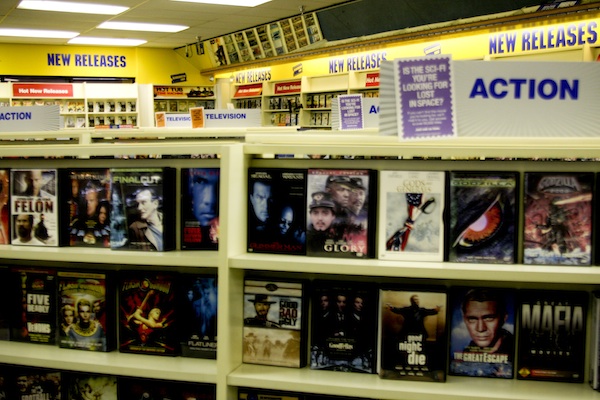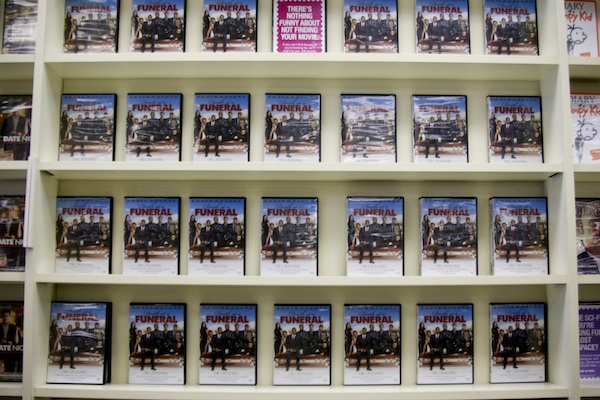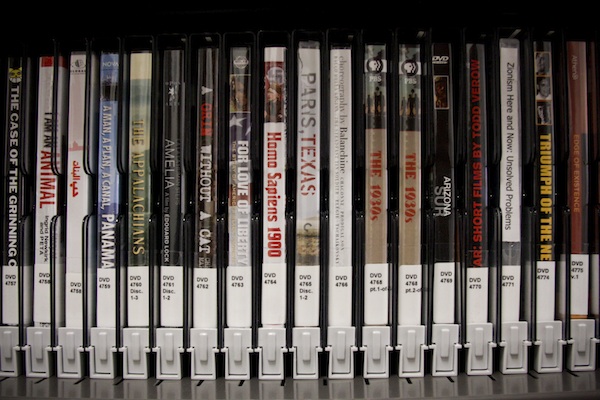Pedagogical Spaces, or, What We’ve Lost in the Post-Video-Store Era
by Roger Beebe
[ PDF version ]
In the current historical moment where the difference and novelty of Netflix as a model for video rental seems to cast into relief the old-fashioned bricks-and-mortar video store, there’s a temptation to think of that latter as a coherent entity. However, while I accept the major differences between Netflix as a hypertextual database and the video store as a physical space, I want to focus my attention here on the different ways that physical space has been parceled in different instantiations of the video store. In fact, rather than focusing on the difference between video stores and their online competitors, I’ll focus here primarily on the differences among video stores (both chain and independent) as well as the difference of video stores from other spaces where videos have been made available to the public: namely, libraries. Looking at these different ways of parceling physical space and of classifying unique physical objects will provide a history of the attempts to think about cinema in and through this recent moment of late capitalism. Additionally, understanding this history will give a better sense of what is lost in the transition to the newer model represented by Netflix.
I should clarify my own stakes in all of this before going any further, because I do have a dog (or dogs, really) in this fight. In 2004, I opened a video store in Gainesville, Florida, where I’ve been living since 2000. The store was formed in reaction to the prevalence of chain video stores here (Blockbuster, Hollywood Video, and Movie Gallery), so many of the gestures I made in setting up the store were made as direct correctives to what I saw as deficiencies in those other stores. I’m also a professor of Film and Media Studies at the University of Florida, and that position and those investments may color my final comments here on what we lose in moving to a web-based model for video rental.
A video store, like any space, represents a set of ideas about those things contained within. Grocery stores, hardware stores, etc. all struggle with the fundamental problem of having both a finite space and physical objects that must be placed somewhere—only one somewhere—within that space. This reality that faces all bricks-and-mortar retailers is what David Weinberger, in his boosterish pro-internet study Everything Is Miscellaneous: The Power of the New Digital Disorder, calls “the first order of order.”[i] A store is, as he declares in the title of his prologue, “Information in Space.”

So the question here is what kind of information different arrangements of the videos in video stores is trying to communicate. The ideology of chain stores has always seemed abundantly obvious. The walls of almost every chain store are (or were, since most of these have now gone out of business) packed floor to ceiling with New Releases. Note that the walls are the only places in these stores where the stock reached the ceiling; all of the center space is generally filled with shelves “measured to the height of a man” to allow clear sightlines of the outer walls at all times. So the first idea this space communicates: the new before all else. Within this New Releases area is a second idea that comes out of the differing amount of real estate given to major studio releases and smaller or (so-called) independent films: commerce before all else. (Even the names of these stores declare[d] their allegiances to the commerce of cinema over the art of cinema: Blockbuster, Hollywood Video, etc. Contrast these names with the quirky names of independent video stores: VisArt Video in Chapel Hill, Odd Obsession in Chicago, Le Video in San Francisco, Movie Madness in Portland, Oregon, and so on).

When videos disappear from the New Releases shelves, they disappear into those lower-visibility shelves in the middle of the space. There, if they’re lucky, they are divided roughly into a handful of major divisions: Comedy, Horror, Science Fiction, Foreign (occasionally), Special Interest (an odd area that encompasses both exercise videos and serious documentaries), Drama (a catch-all for films that fall into no other category), etc. (although this is a very small etc.). The message of this spatial subdivision: genre is the primary filter through which we approach “non-new” films (although we might then wonder about their idea of Foreign and Special Interest as “genres” in some non-rigorous sense, a sense not even used by viewers as guides to their viewing). We should also note that these are very broad divisions, reproducing the expansive categories that Hollywood films necessarily use in their attempt to lure the widest possible audience in an effort to recover their oversized budgets.
At some stores, non-New Releases didn’t even get that rough subdivision; Movie Gallery, for one, notoriously consigned all older DVDs to “the Gallery,” a sprawling display of titles arranged simply in alphabetical order from About a Boy (dir. Chris Weitz and Paul Weitz, 2002) to Zardoz (dir. John Boorman, 1974). But even in chain stores where we do have genre divisions of the non-new titles, we don’t ever see more precise subdivisions of those sections; within Special Interest, for example, there’s no attempt to differentiate the proper documentaries from instructional videos. So after (at best) one round of subdivision, alphabetization rules.
But the order of the alphabet is arbitrary, and there’s a long history of frustration with it as a means of classification. In one of the more hilarious passages in Everything Is Miscellaneous, Weinberger quotes Mortimer Adler, the self-taught polymath editor of the Great Books of the Western World and Encyclopedia Britannica, who calls alphabetization “‘intellectual dereliction,’ ‘an evasion of intellectual responsibility,’ and an ‘intellectual defect.’”[ii] Indeed.
So it is largely against this model that I built my video store, drawing on other exemplars I had encountered in my previous homes of Durham, Berkeley, and Minneapolis. The organizing of the space is radically different, explicitly ideological and pedagogical. (My store is one of the three remaining stores left open in Gainesville; the other two are Blockbusters, although several of their former locations here have already been shuttered). First, rather than dedicating the entire periphery of the store to New Releases, we have a single four-by-eight-foot section of Recent Arrivals, which includes more back-catalog additions than contemporary fare. Rather than dedicating the bulk of that section to hot new Hollywood hits, we almost always have a single copy of each title, essentially leveling the playing field among them. When we do stock multiple copies, which we do for a handful of indie films like Me and You and Everyone We Know (dir. Miranda July, 2005) or Juno (dir. Jason Reitman, 2007), we just stack them on top of each other, so they don’t get any more shelf space than any of the other titles. Instead of having a central gallery that gets out of the way of the sightlines providing constant view of that Recent Arrivals section, we have eight-feet-tall red gridwall shelving that again emphasizes a kind of equivalence between the sections rather than a hierarchy. (To guide the shopper around the store, we’ve hung section titles from our eleven-foot ceilings, but my sense is that these are rarely consulted).

In contrast to the rough subdivisions of older titles into genre categories, our divisions are multi-tiered and complex, so that Documentary, Independent, Comedy, Horror, Science Fiction, Classics, Music, Television, and Animation all have first-level subdivisions, but so do a number of national cinemas (Japan, Germany, France, Italy, England, etc.) Within each of those sections, there are additional subdivisions, mostly based on directors (Dario Argento, David Cronenberg, Wes Craven, et al. in horror; Michelangelo Antonioni, Bernardo Bertolucci, Vittorio DeSica, and so on in Italy), but also often on subgenre (Thrillers, Sports, Gangsters & Gangstas in Drama; Artist Docs, Films about Film, Political Docs, etc. in Documentary) or on actor (Jim Carrey, Chevy Chase, Will Farrell, and others in Comedy). When our imagination fails us—and Drama is one of those places—rather than imposing alphabetical order, we divide up the films by decade. So, instead of a largely undifferentiated division of older films into a handful of generic categories, Video Rodeo (as the stores upon which it was modeled) seeks to offer an increasingly specific ramified system of categorization.

There’s a pedagogy to this arrangement, and it’s clearly making a case for a certain kind of engagement with the cinema and with film history. The prevailing first-order logic is one of national cinemas as a way of thinking about large groups of films together. Within those national cinemas, there’s a decidedly auteurist bent, privileging works by significant directors (toward the start of each section) followed by non-auteurist works from those regions. US films get further important subdivisions based on the mode of production and circulation; they are subdivided into Sub-indie (underground, avant garde, etc.), Independent (following the standard nomenclature of that fraught area), and Hollywood. Hollywood is then subdivided further between auteurist works (with a breakdown stretching from Woody Allen to Robert Zemeckis) and non-auteurist works that are then subdivided by genre.
An additional strategy—and this may be more ideological than pedagogical—is the arrangement of sections from the front of the store to the rear. The store has a narrow central corridor with small alcoves of videos along each side. We consciously front-loaded the store with documentaries on one side and our Sub-indie section on the other. The more mainstream Hollywood fare is pushed much further back in the store, forcing anyone seeking out those titles to run the gauntlet past all of these alternative cinemas.
Of course, with this “first order of order,” things can only be in one place, so while it might make sense, say, to place Punch-Drunk Love (2002) in either the Paul Thomas Anderson auteur subsection in the Independent Film section or in the Adam Sandler subsection in Comedy, our logic says that the auteur prevails. This is hardly unproblematic; we know well the many critiques of the auteur (as a gross oversimplification of the collaborative way almost all films are made, of the predominance of work by men in this vision of history, etc.), but this privileging of the auteur still seemed the least bad way to make sense of the chaos of film history.
We’ve made at times a number of smaller gestures to overcome the limitations of a once-and-for-all ordering of the physical space of the store. For instance, we have at times reclassified titles on a rotating basis (with occasional feature shelves featuring a “Cinematographer of the Month” or a full alcove dedicated to women directors). We’ve also, as a kind of network running through different sections in the store, included rainbow stickers to indicate gay and lesbian titles as well as small stickers declaring that various employees like certain movies. We’ve also listed on a small printout in a few of the genre sections (horror, science fiction) titles that fit those genres but are classified elsewhere in the store (like Stanley Kubrick’s The Shining [1980] and 2001: A Space Odyssey [1968], respectively). These gestures attempt to address the inherent problems of the first order of order, but they may ultimately only be provisional and partial solutions to an ultimately insoluble dilemma.

For a dramatic contrast to these efforts to shape concrete space into a meaningful arrangement, let’s take the example of the University of Florida’s George A. Smathers Library, where the bulk of the university’s media holdings are found. One might expect a certain pedagogical arrangement of an academic library’s film collection to parallel the meaningful arrangement of their print materials per the Library of Congress’s breakdown of subject matter into discreet topics and subtopics. However, what we find there is something radically different from those expectations. DVDs at Smathers Library are simply shelved in the order that they arrive and are numbered sequentially to reflect that order. DVD number 2990 may be Rainer Werner Fassbinder’s Berlin Alexanderplatz (1980) while the adjacent DVD might be Ken Burns’ Baseball (1994). This organization might make interesting collisions happen at random—perhaps we’d want to think about these two series and their relationship to TV financing in the two countries, for example—but it also represents a total abdication of responsibility for any meaningful spatial arrangement of the material that could help instruct browsers in ways of engaging with these films.

This arrangement, strangely, is not particular to Smathers Library; in fact, there’s no equivalent standard to the Library of Congress or Dewey Decimal systems for cataloguing visual media. While this strict numerical order works fine for closed stacks (where users have to consult a catalog—Weinberger’s “second order of order” with “metadata” separated from the objects themselves—and then get a librarian to pull the DVD) or for users who simply want to make targeted strikes (visiting the stacks themselves after prior consultation with some form of catalog), it makes no sense if we still want a spatial array to communicate information.
Perhaps, finally, Smathers Library’s cataloguers would admit that they don’t want the space to function pedagogically. Perhaps they’ve come to embrace that newer order of information (the “third order of order”) where space has been superseded in favor of an online logic of hyperlinks and endless connection. That is, perhaps the library has just decided to remake itself (at least with regard to its visual media holdings) in the image of Netflix (or Amazon.com or the Internet Movie Database). Perhaps they no longer imagine actual physical browsing as a productive activity, supposing instead that the use of a web browser makes that practice obsolete. No longer, as Weingarten loves to point out, are we condemned to stick a DVD in a single place—we can put it in lots and lots of overlapping categories. Punch-Drunk Love can be in both “films directed by Paul Thomas Anderson” and “films starring Adam Sandler” in addition to hundreds of other categories (even “films featuring harmoniums” and “films featuring pudding”—both real IMDb keyword links for that film).
But is this move from ordered space to the hypertextual unequivocally better, as Weingarten would emphatically claim it is? Is nothing lost in this move? A few thought experiments might help to clarify our answers. Imagine starting a university library from scratch. Would we choose to abandon the Library of Congress or Dewey Decimal systems, putting the books in a different order based on some other criterion (date of acquisition or publication, size of the books, alphabetical by title)? Those other orders might have some benefits (like saving space if classified by size or making individual titles instantly locatable when we have the title if done alphabetically), but I don’t think anyone would argue that this somehow makes more sense than the provisional systems of dividing books up into the categories that Melvil Dewey and the Librarians of Congress have devised. Weinberger’s problem with Melvil Dewey (et al.) seems to be that Dewey believed that he could fix these books in discrete categories once and for all. (One can then enumerate all Dewey’s follies that have been magnified with time—philosophy as the most important discipline [hence its placement in the 100s, no base-level number for Islam in the 200s [Religion], etc.) But if we assert instead that this is just one order, an order that was created by a thoughtful person who worked hard to understand the categories into which his contemporaries might group things and which, as a consequence, might be a useful research tool, then that critique falls flat. So as long as physical objects still exist (and books and videos do continue to exist, despite the Amazon and Netflix revolutions), then some thoughtful arrangement still seems better than no order at all.
Weinberger’s polemic is aimed at removing experts from their gate-keeping functions and allowing users to determine on their own what categories might be useful. He sees the proliferation of categories (including “films featuring pudding”) as an unabashedly good thing and embraces the democracy of ideas over what he characterizes as an elitist guarding of culture and knowledge. But I’m not so convinced we want to do away with the gatekeepers in the name of democracy (and I’m certain that his use of the loaded term “gatekeepers” effects an intentional ideological distortion of the role of what might more neutrally be called “experts”). One of the examples Weinberger gives is how patients are no longer condemned to rely solely on their physician for medical advice; they can now go directly to the web and find a whole world of advice, unpublished articles, and so on. But isn’t this democracy of information actually problematic? Don’t we want specialists who’ve spent years studying diseases and their treatment to counsel us (rather than doctors with untested hypotheses, well-meaning hypochondriacs, crackpots with theories, and drug companies)?
Let’s translate this back into the world of cinema. Weinberger sings the highest praises of Amazon’s Listmania, where every Amazon user can post a list of the best of this or that kind of film (in his or her opinion). Those lists might be interesting. Or they might just be frustratingly idiosyncratic and hopelessly uninformed. While it might just be a matter of temperament, I’d actually like to have someone credentialed (e.g., a curator at the Museum of Modern Art, a critic at The New York Times, a filmmaker whose work I like) program a documentary series for me. Credentialing, as a guarantee of seriousness and of a certain shared culture, isn’t just about shutting down a democratic impulse; it’s also about putting these decisions in the hands of people who have a kind of (generally hard-won) expertise in those matters. And in the hands of the owners and staff of most of the video stores that have marked my life, this kind of serious and thoughtful curating is precisely what they offer. I find it incredible that in our post-Wired world, wanting to get medical advice from a doctor or to get help finding a movie by a curator or thoughtful video store owner is somehow seen as a politically conservative idea. Sure, we are unlikely to ever find a video store that’s organized with categories for Films with Harmoniums and Films with Pudding (and where still to place Punch-Drunk Love?!?); but ultimately I’m happy to have been raised in the era of video stores where a handful of devotees of cinema translated their cinephilic ideas into pedagogical spaces. If this is a nostalgic cry, so be it, but LONG LIVE GATEKEEPERS. (Oh, and R.I.P. video stores. You will be missed.)
Photos by Logan Jaffe
Notes
[i] David Weinberger, Everything Is Miscellaneous: The Power of the New Digital Disorder (New York: Henry Holt and Company, 2007).
[ii] Ibid., 30.
Roger Beebe is an associate professor of English at the University of Florida.
 1 Comment
1 Comment
Reader Comments (1)
Hi Roger. I liked the article a lot but your a little pessimistic. Its not that your classification schema is sullied by the increasing ability for anyone to create a classification scheme. Rather as long as a clear delineation of authority is offered in the user interface people will still be able to use your scheme. I don't think you have much to worry about from fanboy123 and his best vid's with cars classification. Take your store online Roger! You will be able to solve your Punch-Drunk-Love question too :-) You can have your students produce their own competing classification, pedagogic or not :-) Take a look at Authoritive Search a first attempt at producing multiple authorities which are clearly identified.
chees lc